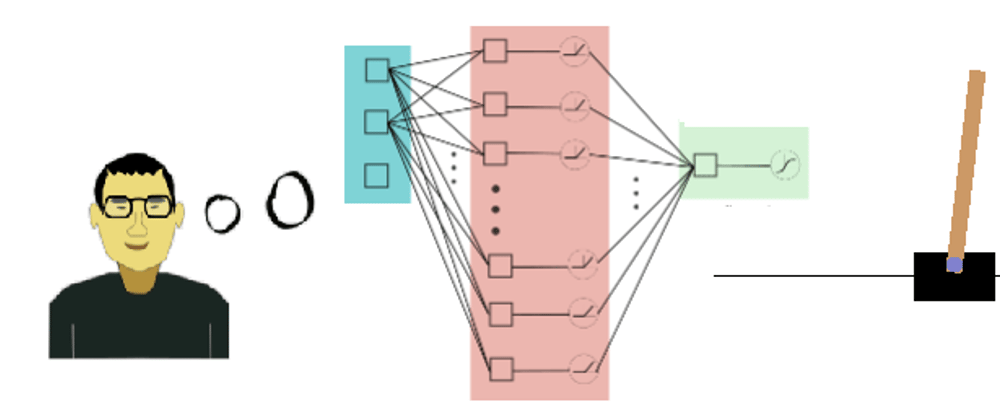Today I started to learn a new RL method: Actor-Critic. The basic idea is quite similar to GAN network. Unlike Policy Gradient in which a single neural network is trained, Actor-Critic uses two neural networks: an "actor" for performing actions and a "critic" for evaluating action of the actor. I refer to this page for details of this method.
Model presentation
Given a state s_t at time t, the network calculates the action probabilities and chooses an action a_t to apply on env:
After the application of action a_t, then env updated accordingly, yields reward r_t, we observe at next time step t+1 a new state s_t+1 which results in a new sampled action a_t+1:
Steps of the basic Actor-Critic method
Unlike the Policy Gradient which needs to gather all data of an episode to calculate gradients, Actor-Critic method performs model update in every agent-env interaction loop :
Implementation with CartPole game
I followed this youtube video for my first Actor-Critic exercise. It was initially based on Keras thus I have modified a little bit of his code for using tensorflow. I also disabled eager mode because of a runtime error (I am using Tensorflow v2 on my laptop).
import tensorflow as tf
tf.compat.v1.disable_eager_execution()
from tensorflow.keras import backend as K
from tensorflow.keras.layers import Activation, Dense, Input
from tensorflow.keras.models import Model
from tensorflow.keras.optimizers import Adam
import numpy as np
import gym
class Agent(object):
def __init__(self, alpha, beta, gamma=0.99, n_actions=2, \
layer1_size=1024, layer2_size=512, input_dims=4):
self.gamma = gamma
self.alpha = alpha
self.beta = beta
self.input_dims = input_dims
self.fc1_dims = layer1_size
self.fc2_dims = layer2_size
self.n_actions = n_actions
self.actor, self.critic, self.policy = self.build_network()
self.action_space = [i for i in range(self.n_actions)]
def build_network(self):
input = Input(shape=(self.input_dims, ))
delta = Input(shape=[1])
dense1 = Dense(self.fc1_dims, activation="relu")(input)
dense2 = Dense(self.fc2_dims, activation="relu")(dense1)
probs = Dense(self.n_actions, activation="softmax")(dense2)
values = Dense(1, activation="linear")(dense2)
def custom_loss(y_true, y_pred):
out = K.clip(y_pred, 1e-8, 1-1e-8)
log_lik = y_true * K.log(out)
return K.sum(-log_lik*delta)
actor = Model(inputs=[input, delta], outputs=[probs])
actor.compile(optimizer=Adam(lr=self.alpha), loss=custom_loss)
critic = Model(inputs=[input], outputs=[values])
critic.compile(optimizer=Adam(lr=self.beta), loss="mse")
policy = Model(inputs=[input], outputs=[probs])
return actor, critic, policy
def choose_action(self, observation):
state = observation[np.newaxis, :]
probs = self.policy.predict(state)[0]
action = np.random.choice(self.action_space, p=probs)
return action
def learn(self, state, action, reward, state_, done):
state = state[np.newaxis, :]
state_ = state_[np.newaxis, :]
critic_value_ = self.critic.predict(state_)
critic_value = self.critic.predict(state)
target = reward + self.gamma*critic_value_*(1-int(done))
delta = target - critic_value
actions = np.zeros([1, self.n_actions])
actions[np.arange(1), action] = 1.0
self.actor.fit([state, delta], actions, verbose=0)
self.critic.fit(state, target, verbose=0)
if __name__ == "__main__":
agent=Agent(alpha=0.0001, beta=0.0005)
env = gym.make("CartPole-v0")
score_history = []
num_episodes = 2000
for i in range(num_episodes):
done = False
score = 0
observation = env.reset()
while not done:
env.render()
action = agent.choose_action(observation)
observation_, reward, done, info= env.step(action)
agent.learn(observation, action, reward, observation_, done)
observation = observation_
score+=reward
score_history.append(score)
avg_score = np.mean(score_history[-100:])
print("episode ", i, "score %.2f average score %.2f" % (score, avg_score))
A newer version
I have updated the program shown above to allow eager mode. The main difference is the introduction of the custom loss function for actor. It works well, however, the running speed is much slower after my modification (I am looking forward to Refactoring it later).
import os
os.environ['TF_CPP_MIN_LOG_LEVEL'] = "2"
import tensorflow as tf
if tf.__version__.startswith("1."):
raise RuntimeError("Error!! You are using tensorflow-v1")
from tensorflow.keras import backend as K
from tensorflow.keras.layers import Activation, Dense, Input
from tensorflow.keras.models import Model
from tensorflow.keras.optimizers import Adam
import numpy as np
import gym
class Agent(object):
def __init__(self, alpha, beta, gamma=0.99, n_actions=2, \
layer1_size=1024, layer2_size=512, input_dims=4):
self.gamma = gamma
self.alpha = alpha
self.beta = beta
self.input_dims = input_dims
self.fc1_dims = layer1_size
self.fc2_dims = layer2_size
self.n_actions = n_actions
self.actor, self.critic, self.policy = self.build_network()
self.action_space = [i for i in range(self.n_actions)]
self.optimizer = tf.keras.optimizers.Adam(learning_rate=self.alpha)
def build_network(self):
input = Input(shape=(self.input_dims, ))
delta = Input(shape=[1])
dense1 = Dense(self.fc1_dims, activation="relu")(input)
dense2 = Dense(self.fc2_dims, activation="relu")(dense1)
probs = Dense(self.n_actions, activation="softmax")(dense2)
values = Dense(1, activation="linear")(dense2)
actor = Model(inputs=[input, delta], outputs=[probs])
critic = Model(inputs=[input], outputs=[values])
critic.compile(optimizer=Adam(lr=self.beta), loss="mse")
policy = Model(inputs=[input], outputs=[probs])
return actor, critic, policy
def choose_action(self, observation):
state = observation[np.newaxis, :]
probs = self.policy.predict(state)[0]
action = np.random.choice(self.action_space, p=probs)
return action
def learn(self, state, action, reward, state_, done):
state = state[np.newaxis, :]
state_ = state_[np.newaxis, :]
critic_value_ = self.critic.predict(state_)
critic_value = self.critic.predict(state)
target = reward + self.gamma*critic_value_*(1-int(done))
delta = target - critic_value
actions = np.zeros([1, self.n_actions])
actions[np.arange(1), action] = 1.0
self.critic.fit(state, target, verbose=0)
with tf.GradientTape() as tape:
y_pred = self.actor(state)
out = K.clip(y_pred, 1e-8, 1-1e-8)
log_lik = actions * K.log(out)
myloss = K.sum(-log_lik*delta)
grads = tape.gradient(myloss, self.actor.trainable_variables)
self.optimizer.apply_gradients(zip(grads, self.actor.trainable_variables))
if __name__ == "__main__":
agent=Agent(alpha=0.0001, beta=0.0005)
ENV_SEED = 1024 ## Reproducibility of the game
NP_SEED = 1024 ## Reproducibility of numpy random
env = gym.make('CartPole-v0')
env = env.unwrapped # use unwrapped version, otherwise episodes will terminate after 200 steps
env.seed(ENV_SEED)
np.random.seed(NP_SEED)
### The Discrete space allows a fixed range of non-negative numbers, so in this case valid actions are either 0 or 1.
print(env.action_space)
### The Box space represents an n-dimensional box, so valid observations will be an array of 4 numbers.
print(env.observation_space)
### We can also check the Box’s bounds:
print(env.observation_space.high)
print(env.observation_space.low)
score_history = []
num_episodes = 2000
for i in range(num_episodes):
done = False
score = 0
observation = env.reset()
while not done:
env.render()
action = agent.choose_action(observation)
observation_, reward, done, info= env.step(action)
agent.learn(observation, action, reward, observation_, done)
observation = observation_
score+=reward
score_history.append(score)
avg_score = np.mean(score_history[-100:])
print("episode ", i, "score %.2f average score %.2f" % (score, avg_score))
The training converges ideally. Below is a snapshot of the execution output:
References:
*https://github.com/wangshusen/DRL
*https://www.youtube.com/watch?v=2vJtbAha3To








Top comments (1)
Hi! I have the same implementation however it takes forever to converge. It does converge but it takes more than 24 hours often. Do you have the same? I have the same code als your first example here :) .
Thanks in advance!